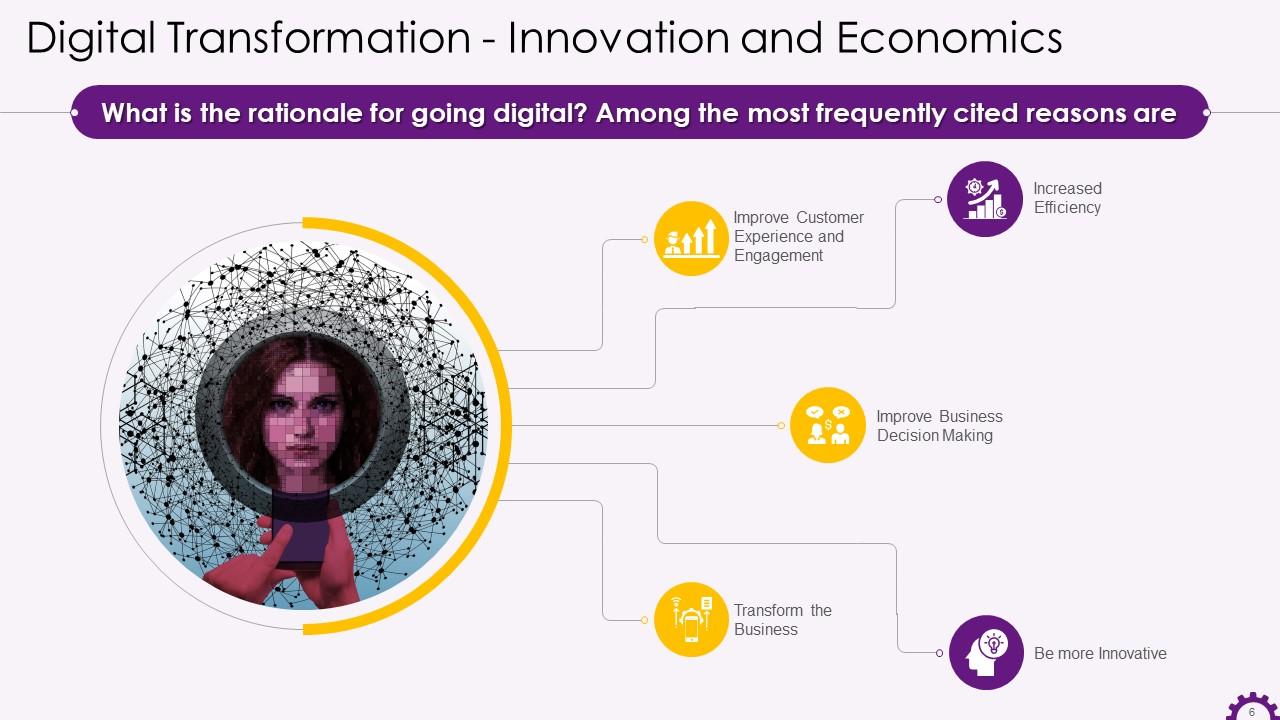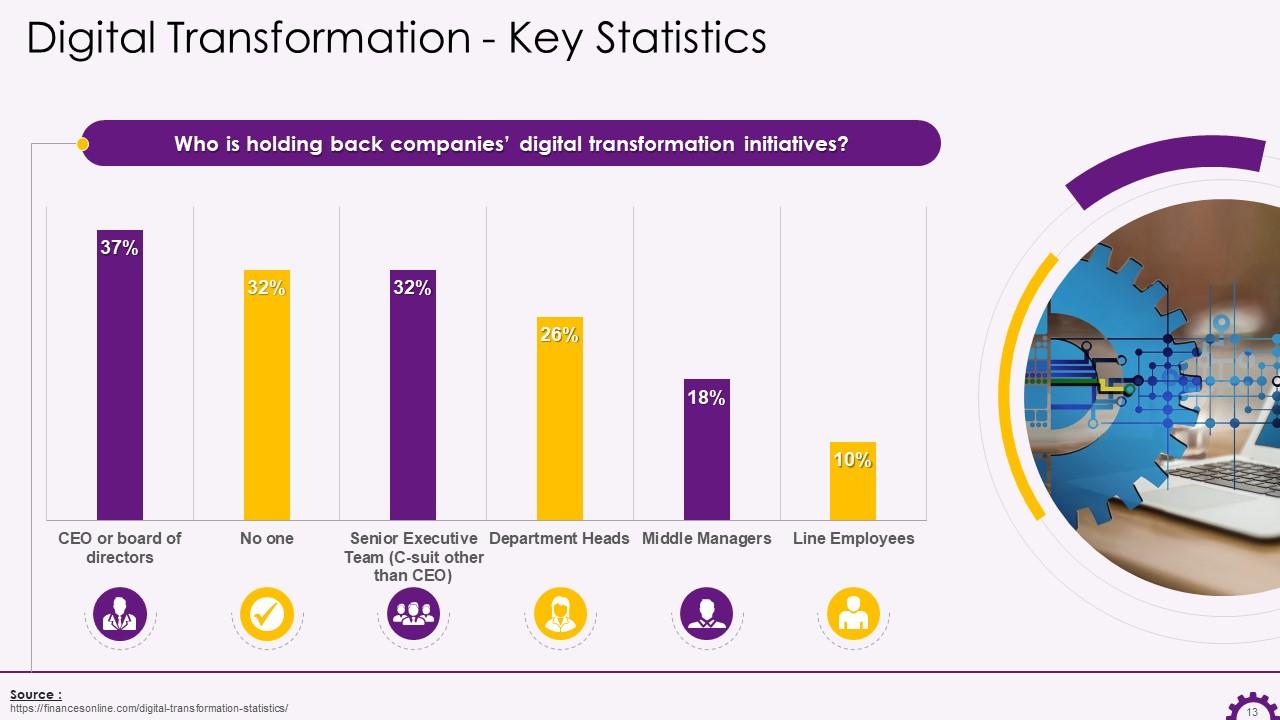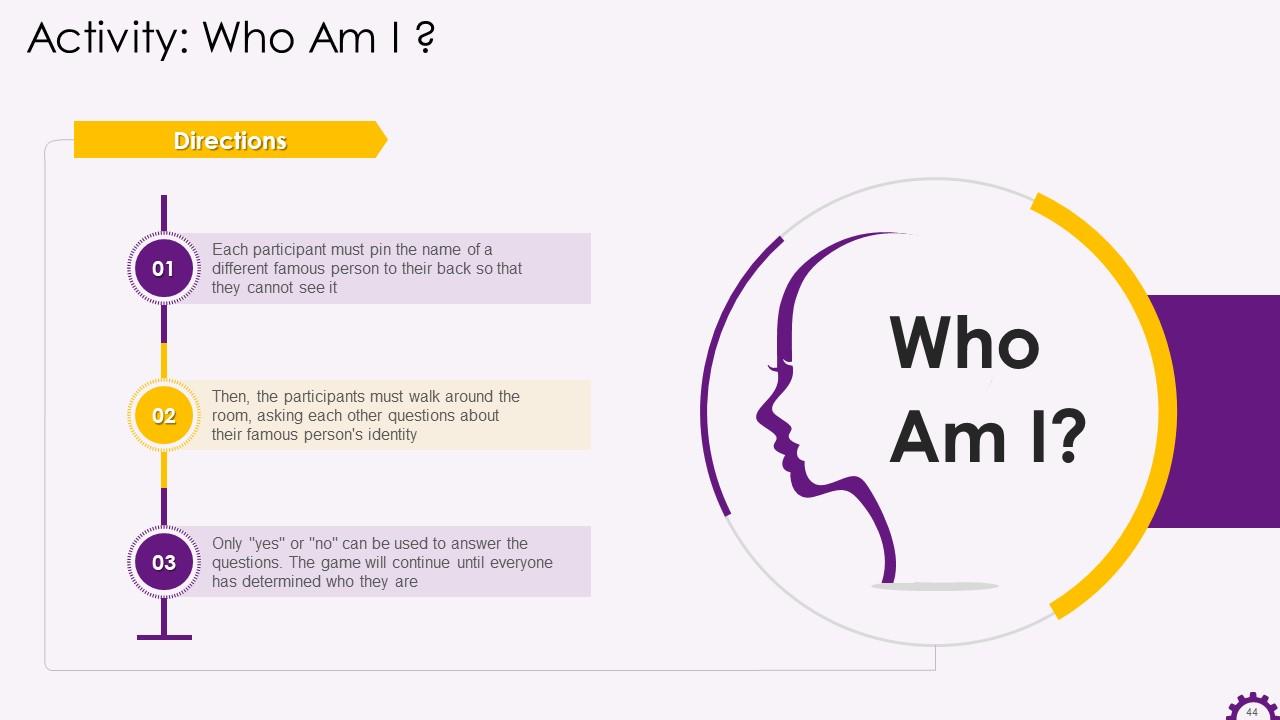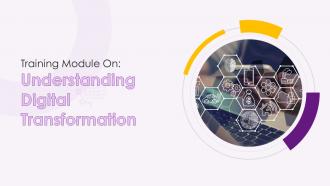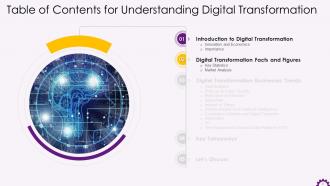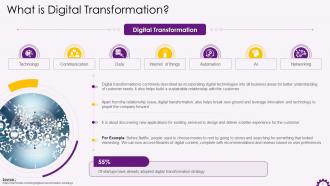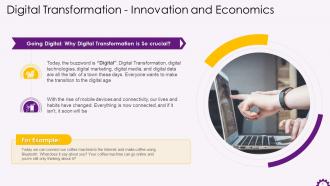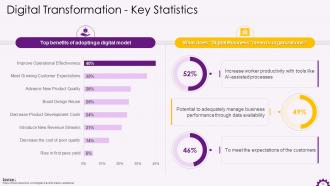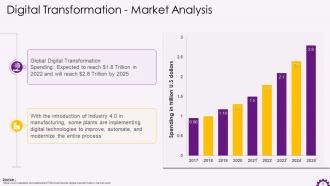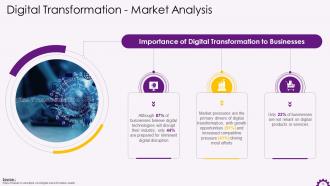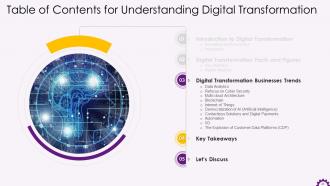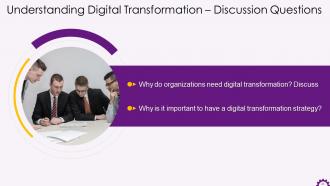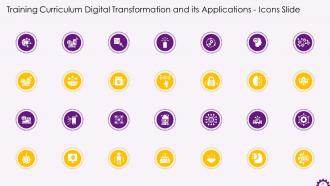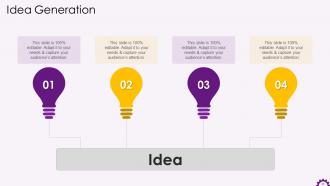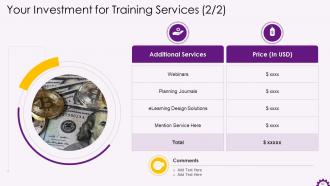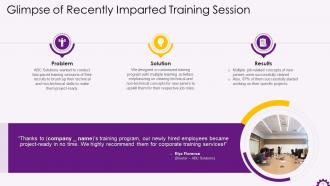Understanding Digital Transformation Training ppt
The training deck in-depth covers digital transformation in business organizations. It has PPT slides on digital transformation facts and figures covering key statistics and market analysis. Further, it covers digital transformation business trends such as data analytics, cyber security, blockchain, the internet of things IoT, artificial intelligence AI, contactless solutions, digital payments, automation, and the explosion of customer data platforms CDP. Further, the digital transformation ppt module has key takeaways and discussion questions to make the training session interactive. It also contains templates on about us, vision, mission, goal, 30-60-90 days plan, timeline, roadmap, training completion certificate, energizer activities, client training proposal, and evaluation form.
- Google Slides is a new FREE Presentation software from Google.
- All our content is 100% compatible with Google Slides.
- Just download our designs, and upload them to Google Slides and they will work automatically.
- Amaze your audience with SlideTeam and Google Slides.
-
Want Changes to This PPT Slide? Check out our Presentation Design Services
- WideScreen Aspect ratio is becoming a very popular format. When you download this product, the downloaded ZIP will contain this product in both standard and widescreen format.
-

- Some older products that we have may only be in standard format, but they can easily be converted to widescreen.
- To do this, please open the SlideTeam product in Powerpoint, and go to
- Design ( On the top bar) -> Page Setup -> and select "On-screen Show (16:9)” in the drop down for "Slides Sized for".
- The slide or theme will change to widescreen, and all graphics will adjust automatically. You can similarly convert our content to any other desired screen aspect ratio.
Compatible With Google Slides

Get This In WideScreen
You must be logged in to download this presentation.
PowerPoint presentation slides
Presenting Training Deck on Understanding Digital Transformation. This deck contains 81 uniquely designed slides. Our PowerPoint experts have included all the necessary templates, designs, icons, graphs and other essential material. This deck is well crafted by extensive research. Slides consists of amazing visuals and appropriate content. These PPT slides can be instantly downloaded with just a click. Compatible with all screen types and monitors. Supports Google Slides. Premium Customer Support available. Suitable for use by managers, employees and organizations. These slides are easily customizable. You can edit the color, text, icon and font size to suit your requirement.
People who downloaded this PowerPoint presentation also viewed the following :
Content of this Powerpoint Presentation
Slide 4
This slide depicts information about digital transformation. It emphasizes that digital transformation is about leveraging innovation and technology to propel the company forward and discovering new applications for existing services to design and deliver a better customer experience. It also mentions that 55 percent of start-ups have already implemented a digital transformation strategy.
Slide 5
This slide illustrates the significance of digital transformation. It emphasizes how the term "digital" has become a buzzword today. It emphasizes how digital transformation, digital technologies, digital marketing, and digital data are currently all the rage. Everyone wants to make the switch to the digital age.
Slide 6
This slide showcases the frequently citied reasons to go digital. The reasons are improved customer experience and engagement, improve business decision making, increase efficiency, be more innovative, and transform the business.
Slide 7
This slide illustrates the significance of a digital transformation strategy. It emphasizes that a digital business strategy is defined as transforming a company's business, streamlining processes, and utilizing technologies to improve interactions with customers and employees. It also mentions that the lack of a digital transformation strategy is the most significant barrier to becoming a digitally mature company.
Slide 8
This slide displays data on the adoption of a digital-first business strategy. It highlights the percentages of digital-first business strategy adoption across industries.
Slide 9
This slide depicts how Amazon, a digital company, dominated the retail industry. It also highlights the valuation of Amazon in comparison to other retailers in the United States.
Slide 10
This slide depicts the pressing need for businesses to go digital. It demonstrates how, even during Covid-19, businesses were able to perform better due to digital transformation. It also states that companies that do not digitally transform will lag behind and eventually go out of business.
Slide 11
This slide depicts the importance of digital transformation. When done right, it results into enriched customer experience, smooth collaboration across departments, data-based insights, enhanced profitability and reduced costs, better agility and innovation, enhanced market penetration, improved decision making, and long-term returns.
Instructor’s Notes:
The importance of digital transformation are as follows:
- Data-based Insights: The use of digital technology allows for more accurate tracking of metrics and increases transparency. Businesses can use these insights to improve their processes and strategies. They can document everything and keep records for better strategic planning
- Smooth Collaboration across Departments: Businesses have access to more data due to digital transformation, and they can analyze which processes or techniques are more efficient. Implementing these efficient processes increases staff productivity. It also allows for open and smooth communication between different teams and departments
- Enhanced Profitability and Reduced Costs: When a company's technology and operations are digitized, it results in greater savings and increased sales. Because digital technology reduces the number of manual interventions, processes become faster and become more accurate. Thus, implementing IT solutions in organizations is highly beneficial
- Better Agility and Innovation: Customers expect better services as technology advances. Digital technology fosters agility and innovation in the workplace and the ability to meet customer demands. Businesses that want to stay relevant must adopt digital transformation services at the earliest
- Enhanced Market Penetration: Unexplored markets can be penetrated, and digital technologies can target newer customers. As business efficiency improves, the market penetration process becomes more effective. It aids in the expansion of customer base and recall of the product or service
- Evolving Customer Expectations: Customer expectations are rising, and every company is working hard to keep up. Consumers can now explore alternatives to meet their needs more efficiently than ever before. As a result, each company has to have customer retention as the key goal. It will only be possible if the company digitally transforms itself to meet the expectations of its customers
- Staying ahead of the Competition: Businesses can now lead because of technological and capability advancements that were unavailable five years ago. If they do not adapt to this shift, they will undoubtedly fall behind their competitors. If a company does not embrace digital transformations, someone else will
- Informed Decision Making: Businesses can benefit from big data by integrating data and analytics into their digital transformation strategy. With the right combination of analytical tools, this data can be transformed into essential business insights, allowing you to make better, faster decisions. The more profound analytical tools are embedded in company operations, the greater is their integration and impact
- Long Term Returns: Digital Transformation may necessitate a significant investment in money, workforce training, and revamping existing organizational procedures, but the benefits will be significant in long-term
Slide 12
This slide depicts the key statistics on digital transformation. It also contains key statistics of the benefits of adopting a digital business model.
Slide 13
This slide illustrates vital data on digital transformation implementation. It also highlights statistics on who in businesses is hesitant to implement digital transformation initiatives.
Slide 14
This slide showcases vital statistics on digital transformation, such as on business opportunities, innovation, and net profit margin.
Slide 15
This slide illustrates statistics on digital transformation adoption and implementation. It also contains information regarding the usage of AI, migration of core HR applications to the cloud, and business leaders who are adapting to new markets and industries by leveraging digital platforms.
Slide 16
This slide illustrates the global digital transformation spending. It highlights that the global digital transformation spending is expected to reach $1.8 Trillion in 2022 and will reach $2.8 Trillion by 2025.
Slide 17
This slide showcases key statistics on the adoption of digital transformation. It mentions the percentage of businesses who have already implemented or plan to implement a digital-first business strategy.
Slide 18
This slide depicts the statistics on the benefits of digital transformation. Among the advantages mentioned are: Increased operational efficiency, faster time to market, and meeting customer expectations.
Slide 19
This slide illustrates statistics on the importance of digital transformation to businesses. It highlights the percentage of businesses that believe digital will disrupt their industry and those that are not reliant on digital products or services.
Slide 21
This slide depicts digital transformation trends. The digital transformation trends are the explosion of customer data platforms, refocus on cyber security, multi-cloud architecture, Blockchain, Democratization of AI (Artificial Intelligence), Internet of Things (IoT), contactless solutions and digital payments, automation, 5G, and data analytics.
Instructor’s Note:
The digital transformation trends are:
- Data Analytics: Data is the company's lifeblood, but it must be sorted, processed, and analyzed to be of any productive purpose for business. Intelligent data analytics can assist you in extracting valuable information from processed raw data. It improves decision-making and increases organizational productivity. It can aid in predicting customer behavior, the optimization of supply chain processes, and optimizing sales pipelines, among other things
- Refocus on Cyber Security: With the recent increase in cyber attacks. Cyber security team members must ensure that the organization's security practices keep pace with the rapid pace of digital transformation. To put it another way, the emphasis should be on "how can we safely speed up a process?" rather than "how can we speed up a process?"
- Multi-cloud Architecture: A multi-cloud architecture uses one or two private or public clouds to distribute software and workloads within an organization. A multi-cloud strategy is used for disaster recovery, data residency, and resilience. Businesses must look for cloud management and automation solutions to manage their cloud environments. These will also help them meet agility requirements and experiment with new delivery models
- Blockchain: Blockchain has emerged as the flavor of the times with its rapid technological adoption over the last year. Initially, associated with crypto currency, blockchain is now being used in industries, particularly financial institutions. Over the years, blockchain will have a significant role in cyber security and it will mature as more industries take to it
- IoT: It is growing, advanced technology and its importance has grown due to the COVID-19 crisis. Organizations across all industries intend to embrace IoT as one of the leading digital technologies. However, leaders in the healthcare and manufacturing industries have shown greater interest in IoT than leaders in the other industries
- Democratization of AI: AI democratization can accelerate digital transformation within a business, making it one of the most important change in business trends. To put it another way, democratizing AI means making it available to every organization and, ideally, every individual within the organization. This entails employing AI-powered tools to detect and recognize trends, make decisions, forecast, learn, and improve
- Contactless Solutions and Digital Payments: The rise of no-touch solutions and contactless digital payments are examples of digital transformation. People and businesses worldwide can now use digital payment methods to gain access to the digital economy. The transition to contactless solutions and digital payments will necessitate robust digital infrastructure support, hastening digital transformation
- Automation: By automating processes, businesses will accelerate digital transformation within their organizations. Business leaders will now need to implement automation practices to keep their businesses afloat and smooth operations
- 5G: 5G can transform business models and operations by enhancing how services are delivered to end-users. It will offer faster speed, lower latency, and greater density than 4G networks. It will also facilitate the adoption of telco cloud, a software-defined technology that will support both current 4G and next-generation 5G networks
- The Explosion of Customer Data Platforms (CDP): CDP is a centralized repository of customer information that can be used to create more personalized and engaging marketing campaigns for the customers. At first glance, CDPs appear to be solely for the marketing department, but this is not the case. Finance and IT departments can also use CDPs to make quick decisions about services, products, and other company investments
Slide 22
This slide illustrates the key takeaways for the session understanding digital transformation
Slide 23
This slide mentions various questions for discussion on the topic understanding digital transformation.
Slide 35 to 50
These slides contain energizer activities to engage the audience of the training session
Slide 51 to 78
These slides contain a training proposal covering what the company providing corporate training can accomplish for the client.
Slide 79 to 81
These slides include a training evaluation form for instructor, content and course assessment.
Understanding Digital Transformation Training ppt with all 86 slides:
Use our Understanding Digital Transformation Training ppt to effectively help you save your valuable time. They are readymade to fit into any presentation structure.
-
Incredibly beautiful designs that will help you get noticed! These eye-catching templates are perfect for corporate presentations that can be altered to fit any occasion or taste.
-
Really like the color and design of the presentation.







